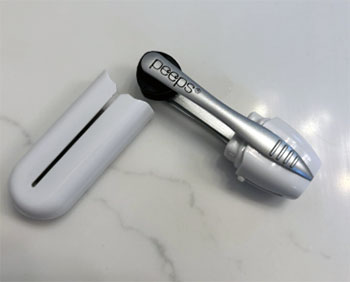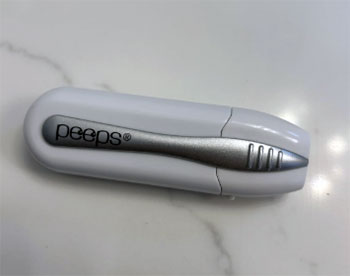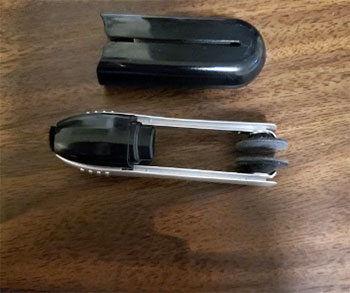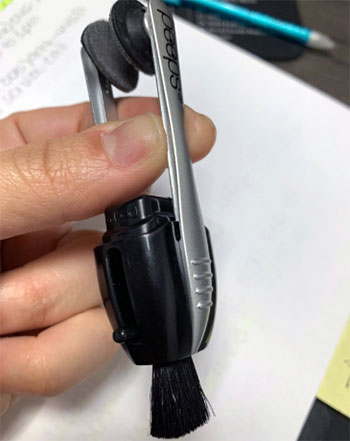If you wear glasses, you know the “greasy lens” struggle is real. You wipe them with your shirt, and it just smears the oil into a foggy mess that makes it harder to see than before. I’ve spent years hunting for a solution that doesn’t involve carrying around a spray bottle like a janitor.
If you want a portable, liquid-free cleaner that uses actual space-age technology to banish fingerprints, you should buy Peeps Glasses Cleaner (available on Amazon or the CarbonKlean website). It’s not perfect, but it’s the closest thing to magic I’ve found for on-the-go clarity.
My Experience With Peeps Glasses Cleaner
My relationship with my glasses has always been a love-hate saga. I love seeing, obviously. I hate the constant maintenance. I have oily skin, and somehow, that oil migrates to my lenses within an hour of washing them. For years, my “cleaning kit” was a grim collection of crinkled microfiber cloths scattered in my car, my desk, and my nightstand. The problem with cloths is that after three uses, they aren’t cleaning anymore; they are just redistributing face grease. I was essentially polishing my expensive prescription lenses with a dirty rag.

I first saw Peeps in a tech gadget video. It looked bizarre—like a weird little pair of plastic tweezers or earplugs.
But the claim that it used “NASA technology” and carbon molecules to clean hooked me.
I’m a sucker for anything that claims to be over-engineered. I ordered a pair in “Space Grey” (naturally) and waited.
When I unboxed it, I was surprised by how small and light it was. It feels almost like a toy.
The design is clever: it has a retractable goat-hair brush on one end and the “tongs” with carbon pads on the other. The main body acts as a recharging station for the pads.
The first time I used it, I almost ruined it. I went straight for the pads without brushing first. Stop. Do not do this. I realized just in time that if I rubbed a grain of sand into my lens with these pads, I’d sandpaper my $400 glasses. I stopped, used the brush slider to pop out the bristles, and meticulously swept away the dust from my lenses. The brush is soft, maybe a little too soft for stuck-on grime, but it does the job for loose particles.
Then came the main event. I pulled the “tongs” out of the case. They look like two little soft arrowheads facing each other. You sandwich your lens between them and rub in a circular motion. It felt strange—there was a bit of friction, unlike the slip-and-slide of a wet wipe. It felt like I was actually buffing the glass.
I pulled the Peeps away and held my glasses up to the light. The smudge from my thumbprint was gone. Not smeared. Not faded. Gone. The lens looked incredibly clear, almost like it wasn’t there. There were no streaks, which is my number one pet peeve with sprays. I did the other lens, then slid the tool back into the case. I heard a little “scrubbing” sound as I pushed it in—that’s the case “recharging” the pads by rubbing them against a carbon reservoir.
I’ve been carrying it in my pocket for three months now. It has saved me during rainy days, humid gym sessions, and greasy lunches. It hasn’t replaced my weekly deep-clean with soap and water, but for the 90% of the time when I just need to see clearly right now, it has become indispensable. It’s not just a cleaner; it feels like a piece of essential everyday carry gear.
Read More: My Thoughts On ACSSart Foam Cleaner
Pros Of Peeps Glasses Cleaner
- Carbon Molecular Technology (NASA Tech): The science behind this is actually fascinating and is the biggest selling point. Peeps uses an invisible carbon compound on the microfiber pads. This isn’t a gimmick; carbon is naturally lipophilic, meaning it loves oil. When you rub the pads on your lens, the carbon literally absorbs the oil molecules from your fingerprints and face grease, lifting them off the glass rather than just spreading them around. This is the same technology used on the Space Station to clean touchscreens and monitors because liquids are dangerous in microgravity. You are getting a specialized, dry-cleaning method that leaves zero residue.
- Zero Liquids or Sprays Needed: This is a massive lifestyle benefit. I travel a lot, and the last thing I want is a bottle of lens fluid leaking inside my laptop bag. Peeps is entirely dry. There is nothing to spill, nothing to refill, and nothing that will get confiscated by TSA. It creates a “self-contained” cleaning system. You don’t need to hunt for a dry cloth to buff off the spray; the tool does the cleaning and the buffing simultaneously. This dry method is also safer for certain lens coatings that can degrade over time with harsh alcohol-based chemical cleaners.
- Incredible Longevity (500 Uses): Most cleaning wipes are single-use trash. A microfiber cloth gets dirty after a week and needs washing. Peeps is designed to last for approximately 500 cleanings. The case is the secret here. Every time you slide the tongs back into the sheath, friction pads inside the case rub against the cleaning tips. This process removes the dirty oils the tips picked up and re-coats them with a fresh layer of carbon. It’s a self-cleaning cleaning tool. For the price, getting 500 effective cleans makes it cheaper in the long run than buying boxes of Zeiss wipes.
- Compact and Durable Design: The form factor is brilliant. It’s about the size of a pack of gum or a lighter. It has a loop so you can attach it to a lanyard or keychain (though I wouldn’t recommend the keychain as it might get banged up). The hard plastic shell protects the delicate carbon pads from getting dirty in your pocket. Unlike a cloth that picks up lint and crumbs in your pocket, Peeps stays pristine inside its little hangar until you need it.
- Safe for All Lens Types: I was worried about my anti-reflective (AR) coating, as some cleaners can strip it. Peeps is explicitly safe for AR coatings, sunglasses, reading glasses, and even polarized lenses. Because it relies on physics (absorption) rather than chemistry (solvents), it is non-corrosive. It polishes the lens surface without eating away at the expensive treatments you paid for at the optometrist.
Cons Of Peeps Glasses Cleaner

- High Risk of Scratching if Used Incorrectly: This is the single most critical downside and the reason for most negative reviews. If there is any abrasive debris on your lens—a grain of sand, a speck of dried mud, a metal shaving—and you clamp the Peeps pads down on it and rub, you will drag that debris across your lens. You will create circular scratches that cannot be fixed. You must use the brush first. If you are lazy and skip the brush step, you are gambling with your lenses. It is not a “mindless” cleaner; it requires a specific two-step process.
- The Shape Struggles with Corners: The “tongs” design consists of two triangular pads. While this shape is great for the center of the lens, I found it difficult to get deep into the corners of my frames, especially near the nose bridge. The pads are somewhat rigid and don’t squish into tight crevices like a cloth does. You often end up with a perfectly clean center lens and a little rim of grease right at the edge of the frame where the Peeps couldn’t quite reach.
- It Cannot Clean “Wet” or “Sticky” Messes: Peeps is designed for oil and dust. It is not designed for food splatter, hairspray mist, or dried soda. If you have something sticky on your glasses, the carbon pads will just smear it and get ruined. The pads themselves will get gummed up and become useless. You still need to use soap and water for “gross” messes. Peeps is strictly for the “fingerprint and face oil” category of grime.
- The Brush Mechanism Can Be Finicky: On my unit, the slider that extends the goat-hair brush is a little stiff. Sometimes the brush doesn’t want to stay locked in the “out” position while I’m sweeping my lenses, and it slides back in. It feels slightly cheaper than the rest of the build. Also, over time, the bristles can get splayed out if you aren’t careful when retracting them, making the brush less effective at flicking away dust.
- The “Replica” Market is Flooded: Because Peeps became a viral hit, there are thousands of cheap knock-offs on Amazon and eBay. These fakes look identical but use cheap foam instead of carbon microfiber. They do not work, they smear grease, and they fall apart. You have to be extremely careful to verify you are buying the authentic CarbonKlean Peeps, or you will have a terrible experience. This isn’t a fault of the product itself, but it is a major hassle for the consumer.
Maintenance Tips For Peeps Glasses Cleaner

- Never, Ever Wash the Pads: This is counter-intuitive. We are used to washing our cleaning tools. Do not wash the Peeps pads with water, soap, or liquid cleaner. Water will ruin the carbon compound. If the pads get wet, they lose their oil-absorbing properties and will streak. Keep this tool bone dry at all times. If you accidentally drop it in a puddle, it’s trash.
- The “Recharge” Ritual: To ensure you get the full 500 uses, you need to properly recharge the pads after every single lens. Don’t just clean the left lens, then the right lens, and then put it away. The correct motion is: Clean Left Lens -> Slide into Case -> Pull Out -> Clean Right Lens -> Slide into Case. Sliding it into the case is what scrubs the dirty oil off the pads. If you skip this, you are cleaning your second lens with the grease from the first one.
- Maintain the Brush: The goat-hair brush is your first line of defense against scratches. Keep it clean. If you see dust building up in the bristles, flick them with your thumb to dislodge it. Do not touch the bristles with greasy fingers, as you’ll transfer that oil to your lenses during the sweeping phase. If the bristles get bent, you can sometimes reshape them, but generally, you just need to be gentle when retracting the slider.
- Know When to Replace: The manufacturer says 500 uses. For most people, that’s about 6 months to a year depending on frequency. You will know it’s time to replace it when the pads start leaving a slight haze instead of a crystal-clear finish. This means the carbon reservoir in the case is depleted and can no longer “refresh” the pads. Do not try to extend its life beyond this point, or you’re just rubbing dirty fabric on your eyes.
- Storage Temperature: While it’s durable, extreme heat can affect the adhesive that holds the carbon pads to the plastic arms. Avoid leaving it on the dashboard of a hot car in the summer. The glue can soften, and the pads might slide off or detach. Keep it in the glove box, a center console, or a bag where it’s shielded from direct solar roasting.
Comparison With Other Brands

- Peeps vs. Traditional Microfiber Cloths: Effectiveness: Peeps is significantly better at removing oil. Microfiber cloths, especially cheap ones, tend to reach a saturation point very quickly. Once a cloth has absorbed some oil, it just pushes the rest around, leaving that annoying rainbow haze. Peeps uses carbon to actively bind the oil, resulting in a streak-free finish much faster.Safety: Microfiber cloths are safer for dust. You can shake out a cloth or wash it. With Peeps, if you fail to brush off a particle, the pressure of the “tongs” will grind it in.Convenience: Peeps wins on portability. Cloths get crumpled, dirty, and lost. Peeps is a self-contained system that stays clean in your pocket.
- Peeps vs. Pre-Moistened Lens Wipes (e.g., Zeiss):Cost: Peeps is a one-time purchase of roughly $15-$20. A box of 200 Zeiss wipes costs about the same. If you use 2-3 wipes a day, the Peeps is far more economical over a year.Waste: Wipes are incredibly wasteful. You generate trash every time you clean your glasses. Peeps is zero-waste until the unit dies.Performance: Wipes are better for “sticky” messes or dried-on gunk because the alcohol cuts through sugar and hairspray. Peeps cannot handle those messes. However, wipes often leave a drying streak that you have to buff off anyway. Peeps leaves no streaks.
- Peeps vs. Ultrasonic Cleaners:The Gold Standard: An ultrasonic cleaner (a water bath that vibrates at high frequency) is the absolute best way to clean glasses. It gets into the nose pads, the hinges, and removes every atom of dirt without touching the lens.Practicality: You cannot carry an ultrasonic cleaner in your pocket. It sits on your bathroom counter. Peeps is for the other 12 hours of the day when you aren’t at home.Synergy: The best routine is to use an ultrasonic cleaner once a week for a deep clean, and use Peeps for daily maintenance and smudge removal. They complement each other perfectly; they are not direct competitors.
Also Read: Comparison Of Air Doctor And Dyson
Frequently Asked Questions (FAQ)
Yes, they work exceptionally well for their intended purpose: removing fingerprints, facial oils, and smudges from lenses. The carbon technology effectively absorbs oils without smearing. However, they are not effective for wet, sticky, or mud-based messes and require the lenses to be dusted off first to avoid scratching.
The manufacturer states that a single Peeps unit is good for approximately 500 cleanings. If you clean your glasses twice a day, one unit will last you roughly 8 to 9 months. The limiting factor is the carbon reservoir in the recharging case; once it is depleted, the pads will no longer clean effectively.
Yes. The carbon cleaning technology used in Peeps was originally developed for and is used by NASA on the International Space Station (ISS) and by the US Military. In space, liquid cleaners are impractical because droplets float away and can damage equipment. A dry, carbon-based cleaning method is essential for maintaining touchscreens, camera lenses, and visors in microgravity.
For a deep clean, warm water and a drop of dish soap (without lotion) dried with a clean microfiber cloth is the gold standard. For portable, on-the-go cleaning of smudges, Peeps is widely considered the best dry option. For sanitizing and removing sticky residue, alcohol-based pre-moistened wipes (like Zeiss) are the best choice.
Conclusion
After months of carrying this little gadget, I can confidently say it is a game-changer for anyone who wears glasses daily. It solves the specific, annoying problem of “oil smear” better than any cloth I’ve ever used. It isn’t a replacement for a weekly soap-and-water wash, and you must respect the brush step to avoid scratches. But if you want crystal-clear vision on demand without the hassle of sprays, Peeps is the product you should buy. It’s a small investment for the luxury of seeing the world in HD.
